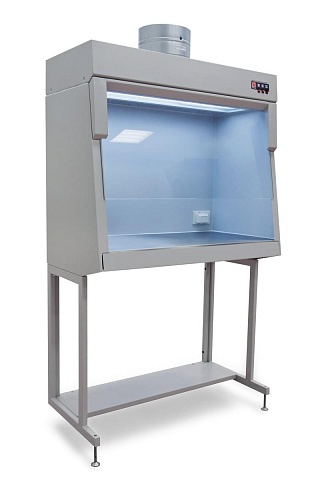The Purpose of Fume Hoods and Laminar Flow Hoods

The Purpose of Fume Hoods and Laminar Flow Hoods
Despite the fact that hazardous fumes and gases might be extremely dangerous, many laboratory
workers have to deal with these unsafe substances on a daily basis. In order to provide protection when
working with biological materials, different types of scientific laboratory hardware were created. A
laboratory fume hood and laminar flow hood are just two of them. At first glance, these containment
devices may appear very similar, as they both use a constant flow of air to prevent contamination when
using sensitive substances.
But they are not the same thing. Despite all similarities, these laboratory appliances differ in how they
operate, what safety level they provide, and which tasks they are most suitable for.
Laboratory Fume Hoods
A laboratory fume hood is a commonly used piece of exhaust equipment in a laboratory room. It is a
closed, vented cabinet that protects lab workers from dangerous particles by venting the air away from
the user and their workplace into the hood.
A fume hood comes with or without air filters. Lamsys specializes in manufacturing fume hoods with no
filters, which means the air travels through the ducts and is then discharged into the atmosphere. The
worker’s safety will also be guaranteed if the substance explodes or spills. However, laboratory fume
hoods neither provide a germ-free work zone, nor prevent chemicals from contaminating.
In short, a laminar fume hood is perfect for all tasks which involve harmful materials, hazardous
chemical vapors, volatile poisonous vapors, reactive materials, noxious gases, particulate matter or
liquids in dangerous quantities and concentrations, flammable or explosive substances, and other
similar substances.
Laminar Flow Hoods
A laminar flow hood (LFH) is widely used for working with lab samples that require maximum sterility
but are safe to inhale. In an LFH, the air travels through the HEPA-filters installed in the hood, and is
then pushed in a unidirectional flow across the work zone. The stream of clean air removes steam,
smoke, and dust that might be generated during various procedures, which guarantees the materials
safety and protection.
It should be noted, however, that laminar flow hoods are not biosafety cabinets. LFHs discharge the
clean air from the back of the cabinet across the working area towards the operator, which leads to the
exposure of chemical substances. Once again: a laminar flow hood, unlike a biological safety cabinet,
only provides protection for the substances being worked on and does not prevent the operator from
inhaling particles emitted by the lab samples.
While laminar flow hoods are not suitable for working with infectious substances, these devices may still
be used for a number of research operations and activities, requiring clean dust-free abacterial air
environments, such as performing cell culture experiments, preparing sterile pharmaceutical products,
or the assembly of sterile equipment.
Protection
The main purpose of a fume hood is to serve as a shield for the laboratory technician, preventing them
from inhaling dangerous fumes and gases. In case of fire or explosion, a cabinet like this may not provide
the necessary protection to the worker, so particularized explosion-proof cabinets should be used to
handle potentially explosive materials.
Conversely, a laminar flow hood prevents the samples from contaminating but does not ensure the
safety of the laboratory worker who is using it.
Airflow
When air travels through the center of the fume hood, it pushes toxic fumes and smoke into the
exhaust area. This air is then vented outside the laboratory through a ventilation system. A ductless
fume hood, one that has no ducts or ventilation, filters hazardous air and discharges it back into the
room.
When it comes to the pattern of the stream of air inside an LFH, these laboratory appliances are
available in two modifications: vertical and horizontal. In a vertical hood, air flows in from above the
HEPA-filter, gets filtered, and the pure air is then pushed downwards towards the working bench.
Horizontal flow hoods, on the other hand, have air enter the hood from behind the filter,
decontaminate it and start to push the clean air forth through the work zone.
Fume Hood vs. Flow Hood
Although a fume hood and an LFH meet different needs, these two devices are essential for laboratories
because they reduce hazards and contaminants when working with various biological materials. When
the cabinet is used properly, it guarantees success in your procedure and makes sure that everything
and everyone involved in it stays safe and protected.

